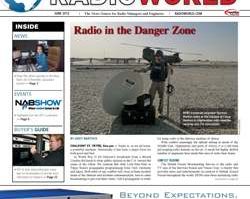
The CBC North Transmitter Site in Deline, Northwest
Territories in Winter. All photos courtesy CBC North
YELLOWKNIFE, Northwest Territories — At 1.79 million square miles (4.6 million square kilometers), northern Canada is larger than India. It encompasses the Yukon, Northwest Territories, Nunavut and northern Quebec, with much of this region above the Arctic Circle, stretching up the North Pole.
In contrast, the mostly native/Inuit population in northern Canada is small; only about 150,000 people in total. Many residents live in relatively large centers such as Whitehorse, Yukon with a population of 35,402; Yellowknife, Northwest Territories, home to 20,536 inhabitants; and Iqaluit, Nunavut with 7,250 people.
VAST
The rest reside in isolated small settlements that can be reached by air or water during the warmer months. Because of this land’s ruggedness, connecting highways are few and far between, although some “ice roads” over the frozen sea are usable during the winter months.
CBC North radio plays a vital role in connecting northern Canadians to each other, and the rest of the world. Working in five studios across the region plus some smaller bureaus, CBC North provides news, weather, and current affairs content in local languages such as Dene Suline, Tlicho, North and South Slavey, Gwich’in, Inuvialuktun and Inuktitut, plus English. Content from CBC Radio One (the country’s main English news/current affairs network) is also aired.
“Our listeners rely on CBC North to keep on top of changing weather conditions and local news, plus events within their northern societies,” said Leitha Kochon. She is host of “Legotse’deh” (North), the North Slavey-language news and current affairs program produced at CBC North Yellowknife broadcasting to approximately 2,000 North Slavey speakers in the Norwest Territories’ Mackenzie Valley. “We are the link that connects them altogether,” Kochon said.

The Announcer/Operator Control Room in
CBC North’s Inuvik Station

A Fish-Eye View of CBC North’s
Kuujjuaq Office and Control Room
CBC North has never been a big operation. Starting as the CBC Northern service in 1958 with a few northern transmitters and production facilities — plus supplemental coverage in northern Quebec via shortwave radio (now phased out due to the demolition of CBC’s shortwave transmission site in Sackville, New Brunswick) — it has now grown over the decades to provide in-town radio (and TV) coverage throughout northern Canada’s scattered communities. “We have quite a big footprint,” said Archie McLean, CBC North’s managing editor.
This said, CBC North runs a very lean set-up. “We typically use 40 W AM or 30–100 W FM transmitters to broadcast our radio signals,” said Lennard Plantz, CBC North’s transmitter maintenance coordinator based in Yellowknife. “The larger communities — above 500 people — have CBC-owned transmitter sites and towers, while the smaller communities are titled Community-Owned Rebroadcasters (CORBs) where the transmitters are located at community facilities such as hamlet offices.”
Due to this low-power approach, signal coverage extends up to 20 miles (32 kilometers) away from each transmitter site at most. As an alternative, CBC Radio is available on the SiriusXM satellite radio system (Channel 169). SiriusXM’s satellite footprint covers nearly all of continental Canada, plus the most-southerly parts of the north’s Arctic islands.

The CBC North Norman Wells, Northwest
Territories Transmitter Site in Summer
LEAN SETUP
Unfortunately, the cost of satellite radios, plus monthly subscription fees, makes this service too expensive for most northern Canadians. As well, the SiruisXM feed carries CBC’s Radio one national service, rather than CBC North.
One irony: Due to CBC Radio’s centralized production system, all content produced in the north is uplinked to an overhead Anik satellite for downlinking at the CBC’s production headquarters in Toronto. The content is then mixed into audio feeds for different parts of northern Canada, with those streams being uplinked to Anik and then downlinked at CBC North’s transmitter locations.
In the studios themselves, CBC North’s programming is produced by “announcer/operators,” who speak on-air and operate the audio board at the same time. Although the norm in Canadian commercial radio, CBC’s southern radio stations tend to divide these two roles. However, the sheer expense of paying and housing staff in the north — where all supplies have to be brought in either by air or, when the ice is gone, by boat — makes announcer/operators a necessity.
In southern Canada, CBC Radio is staffed by professional broadcasters, with training being the prime qualification for employment. At CBC North, however, training is balanced with how well each broadcaster is plugged into the language group(s) they serve.
“We can train people fairly quickly to be broadcasters,” said McLean. “We can’t train them to speak the languages we need plus be known and trusted by the listeners who speak those languages. This is why local people who are well-connected to their communities are our priority.”
Kochon is such a person. She’s a North Slavey speaker who has been with CBC North since 1983, and now plays a central role in keeping her audience informed and entertained. “Many of my listeners don’t speak English; including my parents,” Kochon said. “When it comes to getting weather updates, changes to tax law and fur prices, news about land claim settlements, or just calling into the program to send other community members birthday wishes and stay connected, my show is their lifeline.”
NUMEROUS CHALLENGES
Kochon and other CBC North producers rely on these relationships to provide them with news tips and interview leads. “The land here is so big and travel is so expensive, that I have to count on my contacts and the telephone to produce my show,” she said. “If I get out of the studio to see people more than three times a year, that is quite an accomplishment.”

CBC North’s Studio in Rankin Inlet, Nunavut

A mural detailing CBC North’s broadcast history adorns
the face of CBC North’s Whitehorse studio
Think of Canada’s north, and the word “frozen” comes to mind. But freezing pipes and bitter cold are not the only weather challenges CBC North faces. “Thanks to global warming, we are seeing summer temperatures get up into the high 70s,” said Kevin Woldum, CBC North’s operations manager in Yellowknife.
“Unfortunately, our facilities were never built with the notion of removing excess heat in mind — we don’t have air conditioning, even though some days we now need it.” Even so, it is the generally cold climate combined with northern Canada’s inaccessibility that causes the most headaches.
Food, fuel and housing costs are extremely expensive in the north, because all of the supplies have to be brought in from the south. “There is no such thing as a local hardware store where you can just grab what you need,” said Plantz. “For instance, when we needed a few nails to secure siding that had pulled loose during a wind storm, we had to scour the community to find them.”
Electricity is also an issue. “Our smaller communities run on diesel-powered generators, which are unreliable and prone to failures,” said Woldum. “As a result of downsizing some of our locations do not have on-site technicians. This means it can take some time to recover from faults when the production staff are troubleshooting via telephone with our technicians in the larger centers.”
When outside help is required, it can take days to get CBC technicians up from the south with the necessary know-how and parts to do repairs. “The flights don’t or can’t always fly in northern Canada, and even when they do, the small planes’ limited carrying capacity can result in our techs making it to the station, but not all of their supplies,” Plantz said. “Once you get there, getting around can be pretty daunting; especially if the temperature is below -25F and there are high winds blowing.”

The Snowbound CBC North Transmitter Site in Gjoa Haven, Nunavut
Despite all of the challenges, CBC North soldiers on. You can hear what they are doing at any given time at www.cbc.ca/north/programs, because the feeds from CBC Toronto are also streamed over the Web.
“We know that our listeners count on us around the clock,” said Archie Maclean. “That’s why our people at CBC North work so hard for them, no matter what the weather!”
James Careless reports on the industry for Radio World from Ottawa, Ontario.











